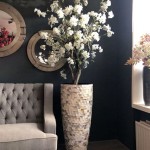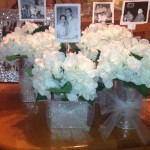Examples of Shabby Chic Decorating
Shabby chic decorating, a style popularized in the late 20th century, embodies a unique blend of elegance and comfort. It embraces aged, worn, or distressed furniture and decor, often featuring a predominantly white or pastel color palette, delicate floral patterns, and an overall sense of romanticism. This decorating style aims to create a relaxed and inviting atmosphere, prioritizing charm over perfection.
The core principles of shabby chic involve repurposing, upcycling, and celebrating imperfections. Items that might be discarded in other design schemes are often given a new lease on life in a shabby chic setting. The goal is to curate a space that feels collected over time, filled with pieces that possess history and character.
Distressed Furniture and Aged Finishes
One of the defining characteristics of shabby chic decor is the use of distressed furniture. This involves furniture items that appear to be worn, aged, or slightly damaged. Instead of striving for a flawless, pristine look, the style embraces imperfections such as chipped paint, worn edges, and visible wood grain. This adds a sense of history and authenticity to the pieces.
Techniques for achieving a distressed look on furniture are varied. One common method involves applying multiple layers of paint, often in contrasting colors, and then sanding away certain areas to reveal the underlying layers. This creates a textured, layered effect that mimics the natural wear and tear that occurs over time. Another technique involves using waxes or glazes to create a faux aged patina.
The type of furniture commonly found in shabby chic interiors includes vintage dressers, antique chairs, and repurposed tables. These pieces are often painted in soft, muted colors like white, cream, pale gray, or pastel shades. The hardware, such as knobs and handles, is also often aged or replaced with vintage alternatives to enhance the overall aesthetic.
Beyond furniture, the concept of aged finishes extends to architectural elements as well. For instance, walls might be painted with a textured finish or adorned with distressed wallpaper. Wooden floors can be left with their natural imperfections or painted and then sanded to create a worn look. These details contribute to the overall sense of age and history that defines the style.
Soft Color Palettes and Floral Patterns
The color palette associated with shabby chic decor is typically soft, muted, and pastel-oriented. White serves as a foundational color, providing a clean and airy backdrop against which other colors can be layered. Cream, ivory, and pale gray are also frequently used as neutral base colors.
Pastel shades such as light pink, pale blue, mint green, and lavender are incorporated to add subtle pops of color and enhance the romantic feel. These colors are often used on furniture, walls, and accessories, creating a cohesive and harmonious aesthetic. The aim is to create a calming and inviting atmosphere, avoiding harsh or jarring color combinations.
Floral patterns are another essential element of shabby chic decor. These patterns often feature delicate, romantic florals such as roses, peonies, and hydrangeas. The patterns can be incorporated in various ways, including wallpaper, fabrics, and decorative accessories. Floral patterns add a touch of femininity and charm to the space.
The scale and style of the floral patterns can vary, but they typically tend towards the smaller and more delicate side. Large, bold floral prints are less common in shabby chic interiors. Instead, the focus is on creating a subtle, understated effect that complements the overall aesthetic. Floral patterns can be used sparingly or liberally, depending on personal preference and the desired level of visual interest. The key is to maintain a balance and avoid overwhelming the space with too many competing patterns.
Fabrics play a critical role in further reinforcing the soft colors. Linen, cotton, and lace are common choices, often in light, airy weaves and textures. These fabrics contribute to the relaxed, comfortable feel that is characteristic of the style.
Vintage Accessories and Decorative Accents
Shabby chic decorating relies heavily on the inclusion of vintage accessories and decorative accents to complete the look. These items add character, personality, and a sense of history to the space. The types of accessories commonly found in shabby chic interiors are varied, but they often include items such as antique mirrors, vintage chandeliers, old books, and decorative ceramics.
Antique mirrors are particularly popular in shabby chic spaces. They can be used to add visual interest to walls, reflect light, and create a sense of spaciousness. Mirrors with ornate frames and aged finishes are especially well-suited to this style. Similarly, vintage chandeliers can serve as focal points in a room, adding a touch of elegance and glamour. Chandeliers with crystal accents and distressed metal finishes are often favored.
Old books are another common decorative element in shabby chic interiors. They can be stacked on shelves, displayed on tables, or used as props in vignettes. Books with worn covers and yellowed pages add to the vintage aesthetic. Decorative ceramics, such as vases, plates, and figurines, can also be used to add pops of color and personality to the space. These items are often displayed on shelves, mantels, or tables.
Other popular decorative accents include lace doilies, embroidered linens, and vintage photographs. These items add a touch of femininity and nostalgia to the space. The key to incorporating accessories effectively is to curate a collection of items that complement each other and contribute to the overall aesthetic. It is also important to avoid overcrowding the space with too many accessories. A sense of restraint is crucial to maintaining the relaxed and inviting atmosphere that defines shabby chic decor.
Flea markets, antique stores, and online marketplaces often provide excellent sources for finding authentic vintage items. Repurposing items also contributes to the overall aesthetic. For example, old crates can be repurposed as shelving, or vintage teacups can serve as planters.
In summary, shabby chic decorating is a multifaceted style that celebrates age, imperfection, and romanticism. It employs a combination of distressed furniture, soft color palettes, floral patterns, and vintage accessories to create a space that feels comfortable, inviting, and full of character. The style encourages creativity, personalization, and the repurposing of old items, making it a versatile and sustainable option for homeowners seeking a unique and charming aesthetic.

Shabby Chic Decorating Is The Style For You Checkout 25 Stunning Furniture Decor Cottage

40 Shabby Chic Decor Ideas And Diy Tutorials 2025

32 Best Shabby Chic Living Room Decor Ideas For 2025

Shabby Chic Decorating Ideas Furniture Mirror Ideal Home

900 Best Shabby Chic Decorating Ideas In 2025 Decor

32 Best Shabby Chic Living Room Decor Ideas For 2025

Shabby Chic Bedroom Ideas To Resurrect Vintage Style Visionbedding

10 Shabby Chic Living Room Ideas Decorating Inspiration For Rooms

20 Shabby Chic Living Rooms

32 Sweet Shabby Chic Kitchen Decor Ideas To Try Shelterness
Related Posts







